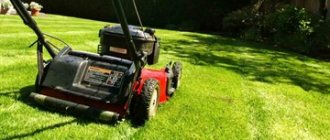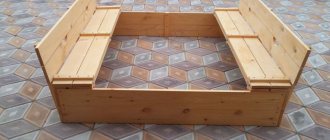Those who live outside the city have an absolute advantage over city dwellers when it comes to outdoor winter activities. You can ski not in a park surrounded by roads and houses, but in a real forest, and sculpt snowmen from pure snow without salt and “chemicals”, and, having sledded down the mountain, without scraping your runners on dirty asphalt. Again, fishing. One minus is that not every cottage village has an ice skating rink. However, this matter can be fixed
You can cooperate with your neighbors and fill a large public skating rink, or you can make it exclusively for your family and friends right on your site - the technology will be the same, the only question is the scale. The main thing is that in the local area there is a place of suitable size with a convenient approach, where the water supply hose can easily be reached.
The area for the skating rink should be level, with firm ground - for example, a well-trodden yard or lawn with natural grass that forms a dense turf. A seeded lawn is not suitable for this purpose - ice on such a soft base will sag and crack, and the lawn itself will begin to hurt in the spring and lose its decorative appearance. In general, the best option for a skating rink is an asphalted or concrete area, although one is unlikely to be found in a private household.
Place for a skating rink
Many people have repeatedly wondered how to make an ice skating rink with their own hands in the courtyard of a house or in any other suitable place for this. It may seem that filling a skating rink is an overwhelming task for a person who has never practiced this before. However, it is not . You just need to have some knowledge, thanks to which the ice will really turn out great and will delight everyone who skates in the cold winter season.
If you decide to fill the skating rink with your own hands, you must first of all find a suitable place in the local area of your private property or in any other suitable place. It is important to take into account that this territory is not guarded by special services or access to it is not blocked by any old buildings.
In the local area, it is best to use the backyard. As a rule, there are all the necessary conditions for filling a skating rink: a relatively flat ground surface, access to water and the ability to constantly monitor the condition of the skating rink.
A hard surface is most suitable for filling the skating rink, otherwise a large volume of water will be consumed, and the ice may crack over time. However, in the absence of a sufficiently hard surface, the ice rink can also be arranged on the lawn , observing the necessary rules .
It is noteworthy that the best base for pouring ice is asphalt, due to its ultra-durable characteristics. Thus, ice forms quickly and can withstand very heavy loads.
Simple ice
American industrial designer Dylan Gastel developed the modular EZ Ice (“Easy Ice”) system for assembling an ice rink in just an hour without using any tools.
The easy-to-store kit includes easy-to-fit 150 x 40.6 cm sides with triangular supports, corner posts, adjustable strap ties with latches and 6 mm thick polymer sheet to line the box before pouring ice.
The ice field can have dimensions of 4.57 × 9.14; 6.1 × 12.2; 7.6 × 15.2; 9.15 × 18.3; 12.2 × 24.4; 18.3 × 30.5 and 25.9 × 60.95 m. Moreover, the slight slope of the terrain is not an obstacle to installing the skating rink.
On online sites, EZ Ice is offered at prices starting from $1,700, depending on the size.
Site preparation
Once a suitable area has been selected, the following manipulations must be performed:
- Mark the boundaries of the future skating rink;
- Make a roller of snow 7-10 cm high along its perimeter so that water does not spill beyond the marked area;
- The area should be properly cleared of snowdrifts and all foreign objects should be removed. In this case, a snow blower or an ordinary shovel will come to the rescue. The area for pouring ice should be as flat as possible, a small layer of snow should cover its surface (3-5 cm). If there are holes, they need to be filled with snow and compacted;
- If possible (not necessary), cover the surface with sand in a layer of at least 5 cm;
- Cover the top of the sand with snow at least 8-10 cm thick, level it and compact it using a shovel or heavy equipment (the denser the surface of the snow, the more reliable the ice will be);
- Leave the site in this condition for at least a day in frosty conditions, due to which the snow will become even more compact;
- If necessary, you can install a fence made of plywood or mesh around the site.
Now you can proceed directly to the filling process itself.
Ready solutions
Ready-made modular skating rink
For those who do not want to build a skating rink themselves or have doubts about the quality of home-made ice, companies specializing in the sale and installation of play and sports equipment offer turnkey installation of modular outdoor skating rinks. The cost of the service depends mainly on the region where the site is located and the size of the ice field. For example, assembling and pouring a standard skating rink 6.1 × 12.2 m, located within 50 km from the Moscow Ring Road, will take 1–2 days and cost about 120 thousand rubles. (in the case of plywood sides 50 cm high with protective linings made of foamed polyethylene) or 240 thousand rubles. (plastic sides, foam pads). * The modular fencing is fixed on supports stuck into the ground, the area is lined with a substrate and ice is poured. The area for the roller must be leveled in advance and not have a slope. Responsible companies certify the equipment and, as a rule, provide a one-year warranty on all its elements.
* According to
A 7.5 × 13.5 m substrate without edges for pouring a 6.1 × 12.2 m platform with detailed instructions for self-installation, with a roll of special repair tape and waterproof glue can be purchased for 27 thousand rubles. In this case, you will have to build the fence yourself. Rollers of non-standard sizes come only complete with plywood or plastic sides at prices of 1300 and 1650 rubles/m², respectively.
Pouring ice
Now the most exciting moment has come - pouring the ice. It must be approached with special responsibility and all necessary rules must be followed:
- The area should be flooded in calm, clear weather at an air temperature no higher than -5 °C.
- Filling should begin from the far side of the site, gradually retreating. It is also necessary to ensure that there are no areas that are not flooded with water.
- Treat the area with water at a temperature of no more than +5°C (otherwise the snow will quickly melt and create holes), using a garden sprayer. To enhance the effect, the procedure can be repeated after the area is covered with a hard ice crust.
- To fill the skating rink better, you need to use a T-shaped structure made of pipes, built with your own hands. In a pipe with a diameter of 25 mm and approximately 150 cm in length, many holes are drilled (the more, the better), after which the pipe is wrapped in soft material, and a water supply pipe is welded. Then water is supplied to this device, which is poured into the desired area. Filling with such a device becomes a very easy and pleasant procedure, because the water is evenly distributed over the entire surface.
- If a pump hose is used for filling, it must be remembered that the stream must be directed upward and fall like a fan so that the surface of the ice is even. The recommended hose angle is 35−45 degrees.
- It is advisable to flood the area at least three times with an interval of 3-4 hours so that the ice becomes as strong as possible. Before each new pour, the ice should be cleaned by removing cracks with wet snow. As a result, the ice thickness should be at least 12-15 cm.
- The last time the skating rink should be filled with warm water. Some people wonder why the skating rink is filled with hot water and not cold. The thing is that under the influence of warm (or hot) water the ice will gradually level out and become of better quality.
If small holes appear on the ice, you just need to fill them with cold water, after which the surface of the skating rink is filled again. This way the roller will become more even.
Knowing how to make a skating rink yourself, you can save money and time on visiting expensive urban indoor skating rinks. At the same time, your own ice rink, if properly cared for, will delight its owners for a long time.
Weather requirements
The skating rink is filled when there is already snow, clear, cold and moderately frosty weather with a temperature of -5...-10C , and the ground is frozen at least 5-7 cm deep. Such conditions are comfortable for humans, and water will not be absorbed into the ground when pouring and will lie flat without freezing directly in the hose.
The degree of freezing of the site can be determined with a bayonet shovel, peeling and lifting the top layer of soil.
In addition, it is better to freeze the skating rink at the dacha in snowless and windless weather: strong wind prevents uniform watering and freezing of water, and falling snow makes the work inconvenient.
Decoration of the territory
You can decorate the area around the skating rink in various ways , for example, by sculpting snow men, making fancy and intricate animal figures or other patterns from garlands. In this case, the author's flight of imagination is not limited in any way.
You should also take care of the lighting of the skating rink, since skating on it will most likely occur often in the evening. This is where outdoor LED spotlights and other lighting devices will come into play. The main thing is to connect the power supply network to the skating rink.
Electric garlands will not only serve as lighting for the area, but will also create an incredibly romantic and magical atmosphere.
Creating a skating rink on your own is not such a difficult task. You need a little patience, as well as knowledge and adherence to certain rules, and, of course, a great desire and indefatigable imagination to bring your plans to life.
Site dimensions
The dimensions of the skating rink should be convenient for comfortable skating: optimally, at least 7-8 m in width and from 12-14 m in length, for example, 7 * 14, 10 * 18, 12 * 25 m, etc. The ratio of the width and length of the skating rink can be kept around 1:2 or a little more, as in large arenas, although other proportions are allowed.
The smaller the rink, the more often you have to make turns on your skates and reduce your speed, while on a larger rink you can accelerate better.
Of course, just to throw a puck at one goal with your son, and even in a small country house, you can fill a smaller court - 4*6 or 5*8 m.
To mark the boundaries of the skating rink, lay bricks in the corners and under the long sides or fill the contours with sand.
The main options for organizing such a business
Ice skating rinks can be roughly divided into three types: open-air, equipped with an air-supported and metal structure. The first option is the cheapest, and the third, accordingly, the most expensive. As a rule, in large cities and metropolitan areas the public is more demanding, so entrepreneurs build skating rinks equipped with metal structures.
In the regions, such leisure facilities are most often built under an air-supported structure, which is a large awning. As for outdoor skating rinks, they are organized almost everywhere in the winter.
Polishing the top layer
It is recommended to spill the topmost layer (do not splash it!) and smooth it with hot water to achieve greater evenness of the skating rink. Under warm water, the ice will melt slightly and freeze again, making the base as even as possible.
It is convenient to do this finishing using a barrel or tank with holes and a piece of hose at the bottom of the container in the form of a tap. A container of hot water is placed on a sled or on a wooden box without a bottom with rubber gaskets. At the bottom of the structure at the back, an old blanket is attached, which, after finishing, erases the traces of the runners.
As a last resort, the skating rink can be polished using a mop.
Let's sum it up
That's all you need to know to create a real skating rink on your street or property. This technique is suitable not only for home use, but also for use on a larger scale. If desired, you can make a skating rink several square kilometers in size!
When all the work is completed, you can not only enjoy skating on your own, but also invite all your neighbors and friends, who will surely appreciate the worthless work.
After all, having your own skating rink is not only fun, but also profitable! You can go out on the ice at absolutely any time and skate as much as you want, no one will forbid you or ask you to pay extra for extra hours. Therefore, if you are tired of sitting at home in winter, you should think about filling your own skating rink in the yard.
On the issue of the lawn
It is not advisable to make a skating rink on top of a green lawn. This will increase the risk that the grass will completely or partially disappear. If you still have to pour a roller on top of the lawn, you should:
- — create a compressed snow base with a thickness of at least 20 cm;
- - pour a reliable ice crust on top of the snow cushion in frosts of -10C so that water does not seep down;
- - in early spring, remove the ice as soon as possible: melt it with a burner; sprinkle with potassium chloride, urea or ash; gently crumble by hand.











